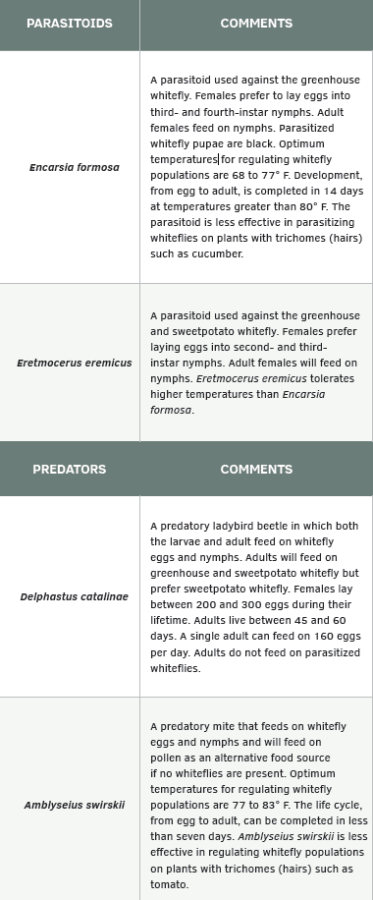Biological Control Agents for Whiteflies
Question: What commercially available biological control agents can be used to regulate whitefly populations in greenhouse production systems?
Answer: Whiteflies are major insect pests of many greenhouse-grown horticultural crops (e.g., vegetables and ornamentals) including: basil, chrysanthemum, cucumber, dahlia, eggplant, fuchsia, geranium, hibiscus, lantana, petunia, poinsettia, salvia, tomato, transvaal daisy and verbena. The two most commonly encountered species are the greenhouse whitefly, Trialeurodes vaporariorum, and the sweetpotato whitefly, Bemisia tabaci.

Although there are many insecticides that are registered for use against whiteflies, another means of managing whitefly populations is releasing biological control agents (natural enemies). The release of biological control agents into greenhouses is an effective strategy for regulating whitefly populations. However, it is important to note that biological control agents must be released early or preventively before whiteflies are present. Consequently, you should order biological control agents early in the production cycle and release immediately upon receipt. In addition, you must understand the optimal environmental conditions (e.g., temperature, relative humidity and photoperiod) associated with all biological control agents to ensure their effectiveness in regulating whitefly populations.
The biological control agents commercially available for whiteflies include the

parasitoids, Encarsia formosa and Eretmocerus eremicus; and the predators, Delphastus catalinae and Amblyseius swirskii. Be sure to order these biological control agents early and conduct a quality assessment upon receipt and prior to release to ensure that the biological control agents are alive. Remember that biological control is a preventative plant protection strategy so biological control agents should be released before whitefly populations are present on the crop (e.g., poinsettia). Contact a supplier or distributor of biological control agents for information on the release rates that are required to regulate whitefly populations. The biological control agents that are commercially available for use against whiteflies are presented in Table 1.
For more information on the management of whiteflies in greenhouse production systems using biological control agents, and images of the four biological control agents discussed in Table 1, download the following Extension publication: “Whiteflies: Management in Greenhouse Production Systems” available at www.bookstore.ksre.ksu.edu/pubs/MF3532.pdf.








 Video Library
Video Library 

















